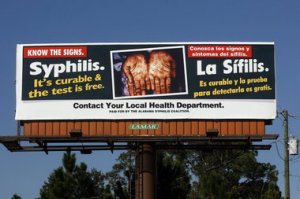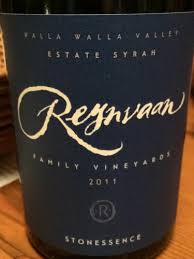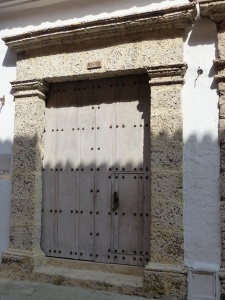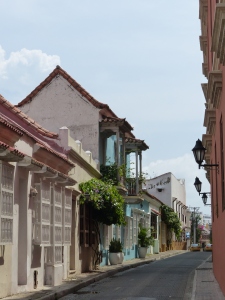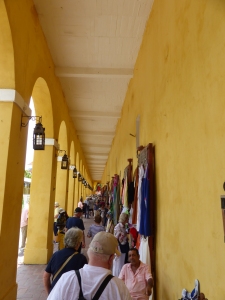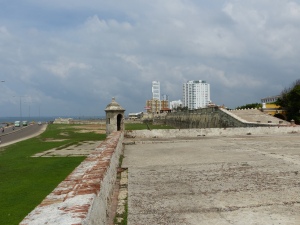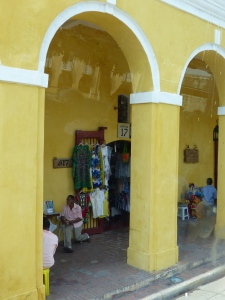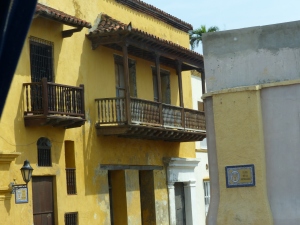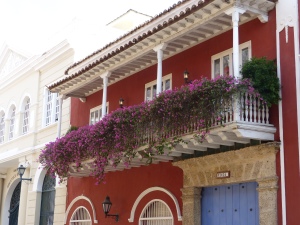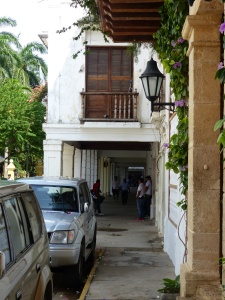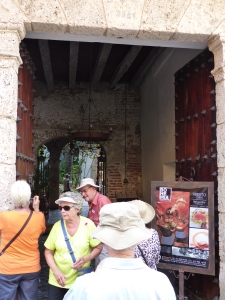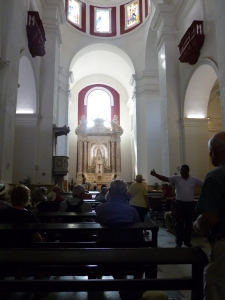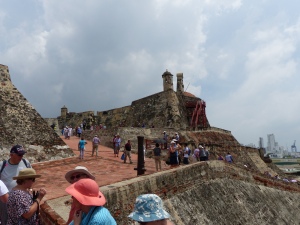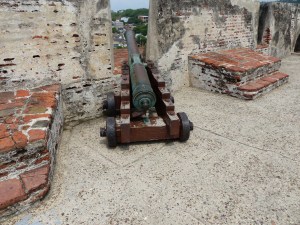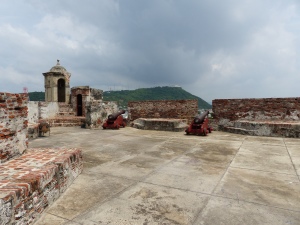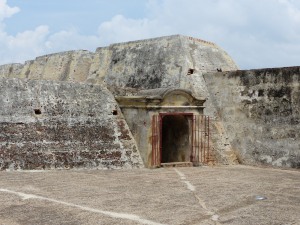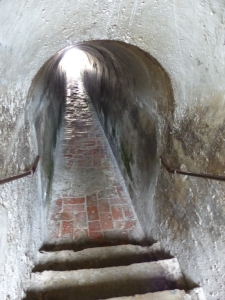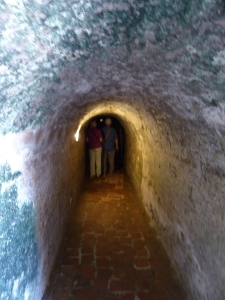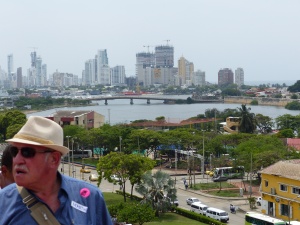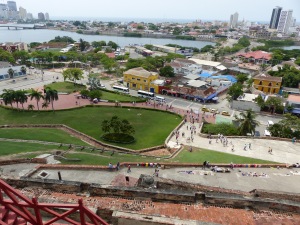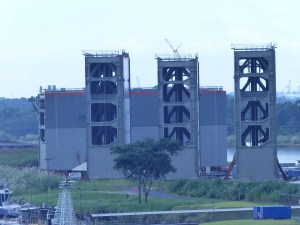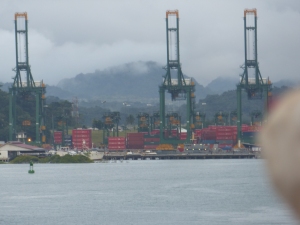The billboard was the last amusing moment for the next several hours. I’ve realized that the more flying I do, the less I enjoy it. The actual flying is great. I love take offs and landings, I love looking down from such a great height and seeing the land below – especially if its night and the lights are illuminating the world, but the hassle to get to where I want to be is becoming far greater than any benefits from the time I save, and I hate airport architecture, design and decor. About the only upside to this part of the trip was that because of the way airports have to be built I definitely got my day’s exercise and then some.
We got to the airport. Because of construction, the driver said, he couldn’t let us off right at two of the terminals – he would split the difference and park at a point between them. People for Airlines A, B and C would go to the right, to Terminal 1 and those of us for Airlines D, E and F, would head to the left. People for Airlines G and H got delivered to the door in the third terminal, lucky people!
He unloaded our bags and we trundled along until we saw an outdoor Delta check-in booth at our terminal. The guy behind the counter called us over, but instead of checking us in, got on the phone, and then told us that the people inside at the Delta counter needed to see us, but didn’t say why. So we went in, lined up and worried. When we got to the front, we were tagged for overweight luggage, which I knew was going to happen, but there was no indication that anybody inside had wanted to see us or talk to us. I’m still not sure why we were sent inside instead of checking the bags right there, unless it had to do with the overweight luggage – but the outdoor guy never touched our bags, so it remains a mystery. One other passenger suggested it had to do with charging us extra for the bags, but . . .. I dunno.
The Delta guy who did the check-in for us decided to play games – first both bags cost $x each. Then, as we were getting the credit card out, he said, no, my bag cost $x, Al’s (which admittedly was heavier than mine) was almost twice that. Why the change, I have no idea. But we had to pay or leave stuff behind, so we paid. Had we been thinking, or had the guy been the least bit helpful, we could have saved ourselves a whack of cash, as we found out later.
But we were feeling the pinch of time. Between the delay at Homeland security and the delay waiting for the bus, we were getting close to boarding time for our flight, and we still had to go through security, so we weren’t as cool and calm as we needed to be – or at least I wasn’t.
But we got the bags checked, got ourselves checked in and then went through security. For some reason, we were supposed to take our computers out of their carry bags and put them in a separate container. I did, Al didn’t. Instead of just asking him to do that, or doing it themselves, they ran his computer bag through, rejected it, pushed him out of line and made him do it all again and lectured him about it. At this point, we needed to be at our gate – boarding was due to start very soon. Or so I thought, so tensions were rising. Well, mine was. And we were hungry – it was well after 2:00 and we hadn’t eaten since 7:30 am. (Yes, four hours to get through customs and what should have been a 10 minute bus ride to the airport.)
We grabbed some food and sat down near our gate to wait for our plane. It arrived about 10 minutes after we were supposed to start boarding. Because it was a commuter flight, people disembarked first. Just about the time we should have started boarding, they announced that due to the weather in Minneapolis, there would be a delay. I went up to see if our connecting flight would be affected, and got told “Well, you can go to the office, or you can wait in line, but by the time you get up to my desk, you probably won’t have much choice of seats.”
?
Shake head.
?
I tried to ask what she meant, but she dismissed me with a “if your flight is more than an hour after arrival, you’re okay.” When was our arrival, I asked. “I don’t know,” she said. Well. That was less than helpful. But she had already turned to the next passenger. A helpful fellow passenger pointed out that if our flight missed the connection, we’d be automatically bumped to the next one. Which was great, except that if that happened, we’d probably miss the connecting Vancouver/Victoria flight and be stuck in Vancouver overnight and not be booked on a next morning flight. This wasn’t looking good. So, what weather was keeping us delayed and would it affect our next flight? Apparently I wasn’t the only one wondering this, and a home truth that should have been obvious to anybody with two operative brain cells became apparent.
You’ve just made an announcement in an airport with free WiFi, to customers who all have smart phones, laptops or (in my trailing edge case) netbooks about the weather in the destination city. You aren’t making sense or being helpful when people ask you questions. So what’s the logical next step for all of those frustrated travelers with smartphones, laptops, netbooks and free WiFi?
Got it in one.
There is no weather in Minneapolis. It’s cloudy. That’s it. No fog, no wind, no rain, no electrical storms, no snow, no sleet, no freezing rain, nothing that would impact our landing (or for the many of us making a connection, our further flights). So . . . what’s going on?
20 minutes later she made another announcement apologizing for the “mistake” and explaining that there was a problem on the wing that needed to be taken care of. Boarding would commence in a few moments. Turns out that the whateveritis that de-ices the wing at high altitude was malfunctioning. Now why couldn’t she have said that in the first place?
We finally boarded, buckled in and took off. And then we got an angel in disguise. The pilot announced that he knew many of us had tight connecting flights and he was going to do his level best to get us there with time to spare. (Ours was more than tight – we were expected to land about 15 or 20 minutes after our connecting flight had left.) He explained that normally they fly a certain path at a certain speed in the interests of economy. But tonight, he had changed the flight path to shorten the journey and was (in an aviation type of way) flooring it. Engaging the after burners? Whipping the seagulls? Feeding the squirrels amphetamines? Overwinding the rubber bands? I don’t know, but whatever it was, he expected to get us in about 15 minutes earlier than expected. The trip was uneventful – boring even. Which was good at this point. Boring was just what I wanted. I got to sit and read uninterrupted for three whole hours, look out the window at dark overcast and be thoroughly uncomfortable in the airplane seat. It was great.
The pilot saved us better than 15 minutes. Enough time that our connecting flight was still on the ground when we got in. I hope they give him a raise! Not only that, but he asked the passengers who didn’t have a connection to please stay in their seats until we’d gotten off. No big deal, that’s standard, and I’ve heard it before and the usual response is to act as if nobody asked anybody to do anything except get off the plane as fast as they can. Except this time people listened. They stayed seated until we were all off! I’m not sure that it really helped, since 3/4 of the passengers had tight connecting flights, but I really appreciated the fact that the ones who didn’t stayed seated for us.
We hustled our buns (and caught one of those golf cart thingees that trundle around airports, giving rides to desperate connecting flight passengers like us) and were the very, very, very last people on the plane. You know in movies when the leading character tears hell bent for leather for the flight and they slam the plane door on his coat tails and the plane is taxiing even as she reaches her seat? Yeah, that was us. And no, it doesn’t feel cool and sexy at all – it’d be embarrassing except that it wasn’t our fault, it was just tense and stressful.
This flight wasn’t quite as uneventful. Lots of turbulence, which I liked. We got into Vancouver on time, made it through customs faster than I’ve ever been through in my life (and I’ve never had any problems with customs), and got another day’s exercise hustling our buns over to the domestic departures terminal, then checked into our flight. And found another angel in disguise.
Remember the overweight luggage? Well, when we weighed it for Air Canada, it was still overweight (no surprise there). The woman suggested that since we had time, if we had an extra bag, we could pay the $20.00 over bag fee and distribute the extra weight so as to save ourselves about $200.00 in overweight charges. We did that. And had very dark thoughts about the Delta guy back in Fr. Lauderdale, who never even thought to be anywhere close to that helpful.
We considered food briefly, but everything was closing up (it was only 9:30ish pm, for crying out loud!) and we decided to just get to the gate and wait until the flight to Victoria was called. Boarding was late for some reason, but we got on, flew over, got off and got our luggage, stepped outside to see the one, the only and last cab drive away. It was late – after midnight, I think. It was chilly. I was tired, and I wasn’t sure how we were going to get home. However, once again, we were rescued. The security guard told us he’d already called the cab company and they were sending more cabs out to pick us up.
We got in at sometime after 12:30. And did the cats greet us ecstatically, purring and rubbing our ankles and demanding pets and cuddles and kibble? If you think so, I want some of what you’re smoking.
No. Sam was lying in the front hall and demanded to know why we were so late coming in so he could be let out. He had to tolerate cuddles (I don’t usually pick him up and cuddle him – he’s not at all a lap cat) because I’d missed him so much. He tolerated it with very poor grace and kept peering around my shoulder at the door. Minou was all complaints about how badly Herb and Charmaine had treated her and what a bully Sam was (I know she was lying through her little front teeth about our house sitters – if anything, they spoil her more than we do, which is saying something). Sam, we learned later, actually had bullied her unmercifully.
In the morning (or later that morning) we’d figure out what things had changed since we’d been away and what progress had been made on the construction next door – but for now it was cuddle the (unwilling) cats, let Sam out and collapse into bed. When we did the time calculations, it was no wonder we were exhausted – we’d been up for 24 internal hours. Not an awful, horrendous trip home, but certainly not the way I’d have preferred to end our journey. Still, we got home safe, everything we’d taken was there, nothing was broken and the house hadn’t burned down. A win all round.
It’s been a ride – both the trip and writing about it. Thank you for coming with me, and I hope you enjoyed it. Stay tuned, because the next adventure is right here at home – the saga of the house next door. That one won’t be nearly as upbeat, but I suspect there will be some chuckles.
